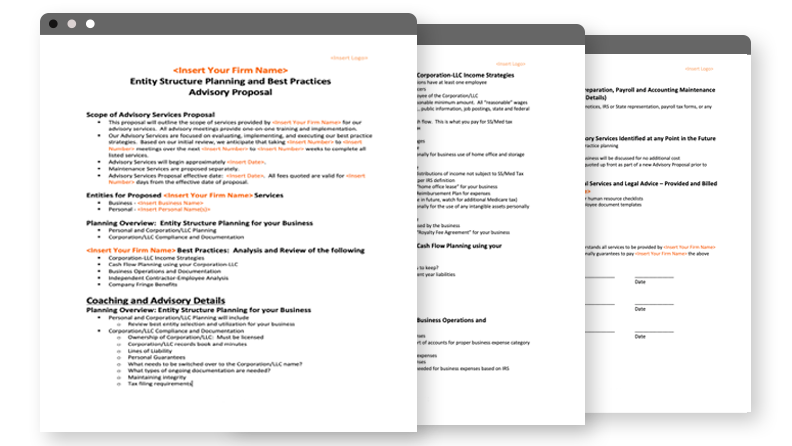Communication tips, details of a consulting proposal, templates, and more.
Jump to ↓
| How to communicate with clients effectively |
| What should an advisory consulting proposal include? |
| Writing an advisory services proposal with a template |
| An easier way to write advisory proposals |
The shift toward providing more higher-value advisory services continues to gain momentum as accounting firms increasingly look for ways to better serve clients, sharpen their competitive edge, and drive greater profitability.
A recent Thomson Reuters Institute survey found that 95% of tax professionals believe their clients want at least some business advisory services. Success, however, is not a given. Building a profitable advisory business entails having the right tools and resources in place to deliver the services in a scalable way. One of the first steps to engaging clients is to understand the nuances of an effective advisory services proposal.
To help accounting firms on their path to profitability, this article will take a closer look at client communication tips, the components of an advisory services proposal, how to put together a proposal with a template, and more.
How to communicate with clients effectively
It may sound obvious, but effectively communicating with new and existing clients is critical. There are several reasons why this is important, especially in today’s business environment.
For starters, it is human nature for people to feel less anxious when they are informed. Opening the doors of communication and clearly defining potential services help firms effectively manage client expectations and avoid scope creep.
It is also important that clients, and prospective clients, have a clear understanding of the value the firm is providing. Why? Accountants offering strategic advisory services must ensure they are being properly compensated for their knowledge and expertise. And when clients recognize the value, they are more willing to pay for those services.
So how can firms improve client communication? Consider the following:
- Be transparent: Transparency helps strengthen client relationships and helps firms avoid potential disputes.
- Manage client expectations: This means setting realistic goals, timelines, and deliverables with clients from the outset.
- Be proactive: Today’s clients want to work with a firm that is proactive versus reactive. For example, proactively communicating with clients (i.e., emailed newsletters, webinars, etc.) on the potential impacts of new legislation and informing them that you are on top of the developments can preemptively answer questions they may have and ease their anxiety.
- Strengthen soft skills: Soft skills are more intangible skills like effective verbal and written communication, problem solving, and critical thinking. Possessing strong soft skills is critical, especially when providing clients with strategic advisory services. Given that soft skills can be challenging to teach, it is beneficial to evaluate your staff’s abilities and capitalize on the skills of those who naturally excel in these areas.
- Use secure communication channels: Ensure that you are using secure collaboration tools with clients, like a two-way client portal, when sending or receiving documents that contain sensitive data.
- Make it easy: Today’s clients have grown accustomed to the conveniences of mobile apps and other online tools. Making it easy for clients to collaborate — via e-signatures, digital document uploads, etc. — enables your firm to better serve them.
What should an advisory consulting proposal include?
An advisory consulting proposal, which is typically written after speaking with a client or prospective client about a proposed project, is more than just paperwork. It marks the start of the arrangement, shifting the conversation into an active client relationship. A successful advisory engagement starts with a good advisory services proposal.
The key elements of an advisory proposal include:
- A summary: This should provide a brief overview and main points of the project.
- The objective: This should outline the goal of the project and desired outcomes. Be clear and outline how you will define success. In other words, make it measurable.
- The plan of action: The proposal should include the steps the firm plans to take to achieve the desired goals. Be as specific as possible.
- The deliverables: What can the client expect from the firm? Managing client expectations upfront can help avoid any potential miscommunication.
- The terms and conditions: Be sure it clearly states contractual information like the fees, anticipated start and completion dates, and other important terms. Remember, clients want and expect transparency.
How to present a clear value proposition
Presenting a clear value proposition involves knowing the client’s main challenges, being familiar with their business and industry, understanding the client’s main competitors, and communicating the benefits of the services being provided.
When clients have a clear understanding of the value the firm brings to the table, they will be more confident in their decision to hire the firm and will be more willing to pay for those services.
Advisory services agreement versus proposal
What is the difference between an advisory services agreement and an advisory services proposal? Keep in mind that a proposal of any kind is intended to persuade someone to take a specific action. In this case, an advisory proposal is intended to persuade the client or prospective client to hire the firm for its advisory services.
Unlike a services agreement, a proposal is not a legal contract. Once the client has received and agreed to the advisory proposal, the services agreement, which is a legal contract, is created and signed by both the firm and the client.
Writing an advisory services proposal with a template
Leveraging the right tools and resources, like advisory maps and templates, can help firms drive efficiency and achieve greater success. Let’s first take a closer look at advisory maps.
An advisory map helps firms evaluate and determine the best options for their clients and lays out the phases and tasks required in the advisory process.

To further illustrate, consider the following example: a firm is advising the client on an installment sale to defer payment of tax. An advisory map will outline the following key steps:
- Determine if the property is eligible for installment sale treatment.
- Determine if the installment sale is advisable under the circumstances.
- If applicable, elect out of installment sale treatment.
- Review draft of sales agreement for compliance with the tax rules.
- Analyze income tax consequences.
- Consider estate tax consequences.
Advisory maps help empower firms to deliver successful advisory services by providing a step-by-step process that practitioners, even junior accountants, can follow with confidence. With the framework in hand, a template can then be used to develop an effective advisory proposal.
Using advisory proposal templates, firms can build proposals faster and more efficiently. The template helps show new and existing clients exactly what is — and is not — included in their advisory engagement. You can further position your firm as the industry leader by leveraging pre-made templates that are customizable to display firm-specific details and branding.

Leveraging advisory maps and templates helps firms save time, expand bandwidth, and build a scalable advisory services practice.
An easier way to write advisory proposals
Empower your firm to engage clients and communicate with complete clarity using advisory proposal templates that provide a great starting point and customization for firm-specific details and branding.
In today’s dynamic business environment, the shift toward providing more higher-value advisory services continues to gain momentum. Clients want and expect more and those firms that heed the call stand to reap the benefits. Is your firm among them?
Turn to a solutions provider like Thomson Reuters, which has the time-saving tools and proven roadmap that your firm needs to build a successful and scalable advisory practice.
 |
|








